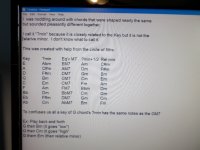I was noodling around and found minors that were shaped nearly the same as a major
but sounded very different and pleasant together.
I call it "?min" because it is closely related to the Key but it is not the
relative minor. I don't know what to call it - the key's M7 alter-ego"
Bm and GMaj7 have the same notes. So why do we have 2 names for the same chord?
*** See: Jim Yate's reply #6 ***
This was created with help from the circle of 5ths: (Sorry, this editor doesn't recognize tabs.)
Key ?min Eq'v M7 ?min+1/2 Rel min
E Abm EM7 Am C#m
A C#m AM7 Dm F#m
D F#m DM7 Gm Bm
G Bm GM7 Cm Em
C Em CM7 Fm Am
F Am FM7 Bbm Dm
Bb Dm BbM7 Cm Gm
Eb F#m DM7 Gm Cm
Ab Cm AbM7 Bm Fm
Ex: Play back and forth
G then Bm (it seems to go "low")
G then Cm (it seems to go "high"
G them Em (...the relative minor)
The chart looks like this:
but sounded very different and pleasant together.
I call it "?min" because it is closely related to the Key but it is not the
relative minor. I don't know what to call it - the key's M7 alter-ego"
Bm and GMaj7 have the same notes. So why do we have 2 names for the same chord?
*** See: Jim Yate's reply #6 ***
This was created with help from the circle of 5ths: (Sorry, this editor doesn't recognize tabs.)
Key ?min Eq'v M7 ?min+1/2 Rel min
E Abm EM7 Am C#m
A C#m AM7 Dm F#m
D F#m DM7 Gm Bm
G Bm GM7 Cm Em
C Em CM7 Fm Am
F Am FM7 Bbm Dm
Bb Dm BbM7 Cm Gm
Eb F#m DM7 Gm Cm
Ab Cm AbM7 Bm Fm
Ex: Play back and forth
G then Bm (it seems to go "low")
G then Cm (it seems to go "high"
G them Em (...the relative minor)
The chart looks like this:
Attachments
Last edited:



